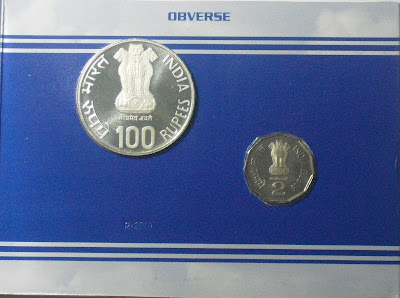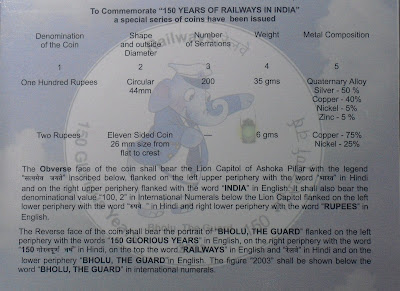A few months back some restrike sets were released by the Kolkata mint which caused some issue with the collector community. Apparently people had divided opinions over the legality and the ethics of the restrikes. After a while, I got to know that the mint had put some pointers , some insignia so that people could differentiate between the original and the restrike. Whether this move was a result of petition filed by a group of collectors or it was just a whim of the mint management, I do not know. But if you want to know if a particular set is a restrike or original, you can see the second picture here(The proof set obverse). It has the letters R2010 embossed on it conveying clearly that it was booked as a restrike in 2010(Though the coins in it could have been minted in 2003 itself).
The originals would always have a higher demand so I booked very few of the restrike sets. According to me only the railways restrike is worth it so I have already sold out the rest of the restrikes I had and bought originals for all the restrikes I sold.
The originals would always have a higher demand so I booked very few of the restrike sets. According to me only the railways restrike is worth it so I have already sold out the rest of the restrikes I had and bought originals for all the restrikes I sold.
Railways restrike proof set cover
 This coin was minted on the occasion of the completion of 150 years of the Indian railways since its inception on April 16, 1853. The 150th year was marked by year long celebrations and was capped off by unveiling the railway mascot, Bholu the elephant, which is also shown on the obverse of this coin. The elephant was chosen as a mascot because elephants carry load, and are not aggressive. Thus the mascot keeps in line with the projected "big, friendly and helpful" image of the Indian railways.
This coin was minted on the occasion of the completion of 150 years of the Indian railways since its inception on April 16, 1853. The 150th year was marked by year long celebrations and was capped off by unveiling the railway mascot, Bholu the elephant, which is also shown on the obverse of this coin. The elephant was chosen as a mascot because elephants carry load, and are not aggressive. Thus the mascot keeps in line with the projected "big, friendly and helpful" image of the Indian railways.The novel plan for the introduction of a rail system, transformed the whole history of India. This innovative plan was first proposed in 1832; however no auxiliary actions were taken for over a decade. In the year 1844, private entrepreneurs were allowed to launch a rail system by Lord Hardinge, who was the Governor-General of India. By the year 1845, two companies were formed and the East India Company was requested to support them in the matter.
The credit from the UK investors led to the hasty construction of a rail system over the next few years. On 22nd Dec' 1851, the first train came on the track to carry the construction material at Roorkee in India. With a passage of one and a half years, the first passenger train service was introduced between Bori Bunder, Bombay and Thana on the providential date 16th Apr' 1853. This rail track covered a distance of 34 kms (21 miles). Ever since its origin, the rail service in India never turned back.
The British Government approached private investors and persuaded them to join the race with a system that would promise an annual return of 5% during the early years of operation. Once finished, the company would be transferred under the Government ownership, yet the operational control will be enjoyed by the original company. In 1880, the rail network acquired a route mileage of about 14,500 km (9,000 miles), mostly working through Bombay, Madras and Calcutta (three major port cities).
By 1895, India had started manufacturing its own locomotives. In no time, different kingdoms assembled their independent rail systems and the network extended to the regions including Assam, Rajasthan and Andhra Pradesh. In 1901, a Railway Board was formed though the administrative power was reserved for the Viceroy, Lord Curzon. The Railway Board worked under the guidance of the Deptt of Commerce and Industry. It was comprised of three members - a Chairman, a Railway Manager and an Agent respectively.
For the very first time in its history, the Railways instigated to draw a neat profit. In 1907, most of the rail companies were came under the government control. Subsequently, the first electric locomotive emerged in the next year. During the First World War, the railways were exclusively used by the British. In view of the War, the condition of railways became miserable. In 1920, the Government captured the administration of the Railways and the linkage between the funding of the Railways and other governmental revenues was detached.
With the Second World War, the railways got incapacitated since the trains were diverted to the Middle East. On the occasion of India's Independence in 1947, the maximum share of the railways went under the terrain of Pakistan. On the whole, 42 independent railway systems with thirty-two lines were merged in a single unit and were acknowledged as Indian Railways. The existing rail networks were forfeited for zones in 1951 and 6 zones were formed in 1952. With 1985, the diesel and electric locomotives took the place of steam locomotives. In 1995, the whole railway reservation system was rationalized with computerization.
So inspite of all the difficulties, and whatever may the reason be for the British building the railways, this was one good work that the British did in India that proved immensely beneficial for us in the long run.
Compsoition










dear kul raj ji i like very much the sentence published in ur site...
ReplyDelete"An unidentified coin is a piece of metal. But an identified coin is a piece of history."
ur site is wonderfull
thank you
ravimurru-the-numismatist.blogspot.com
Is the booking for these coins finished? I dont seen any link anywhere.. Please help m with the correct links..
ReplyDeleteBooking is closed long back.
ReplyDelete